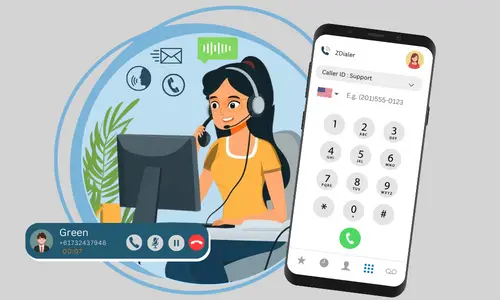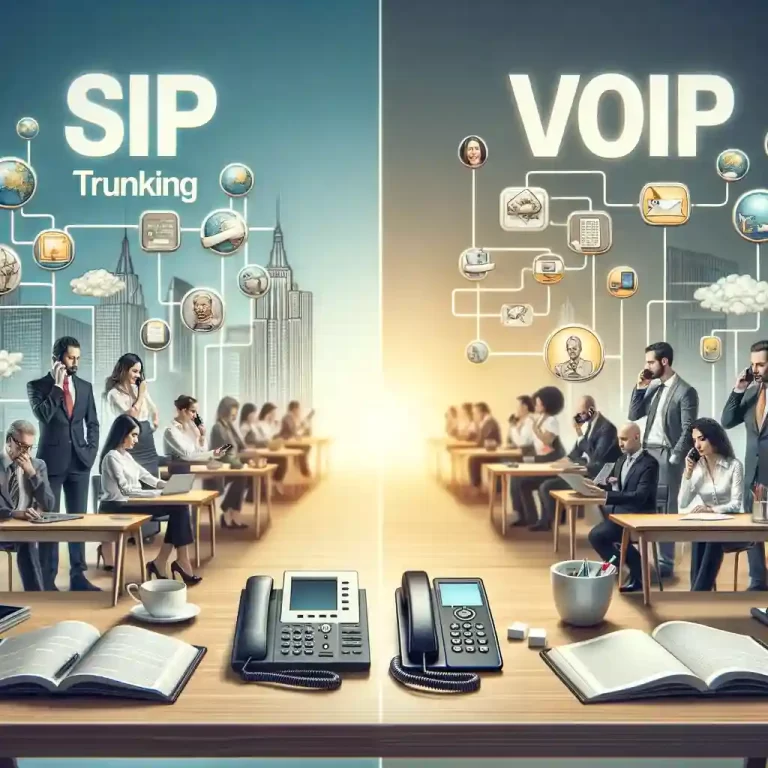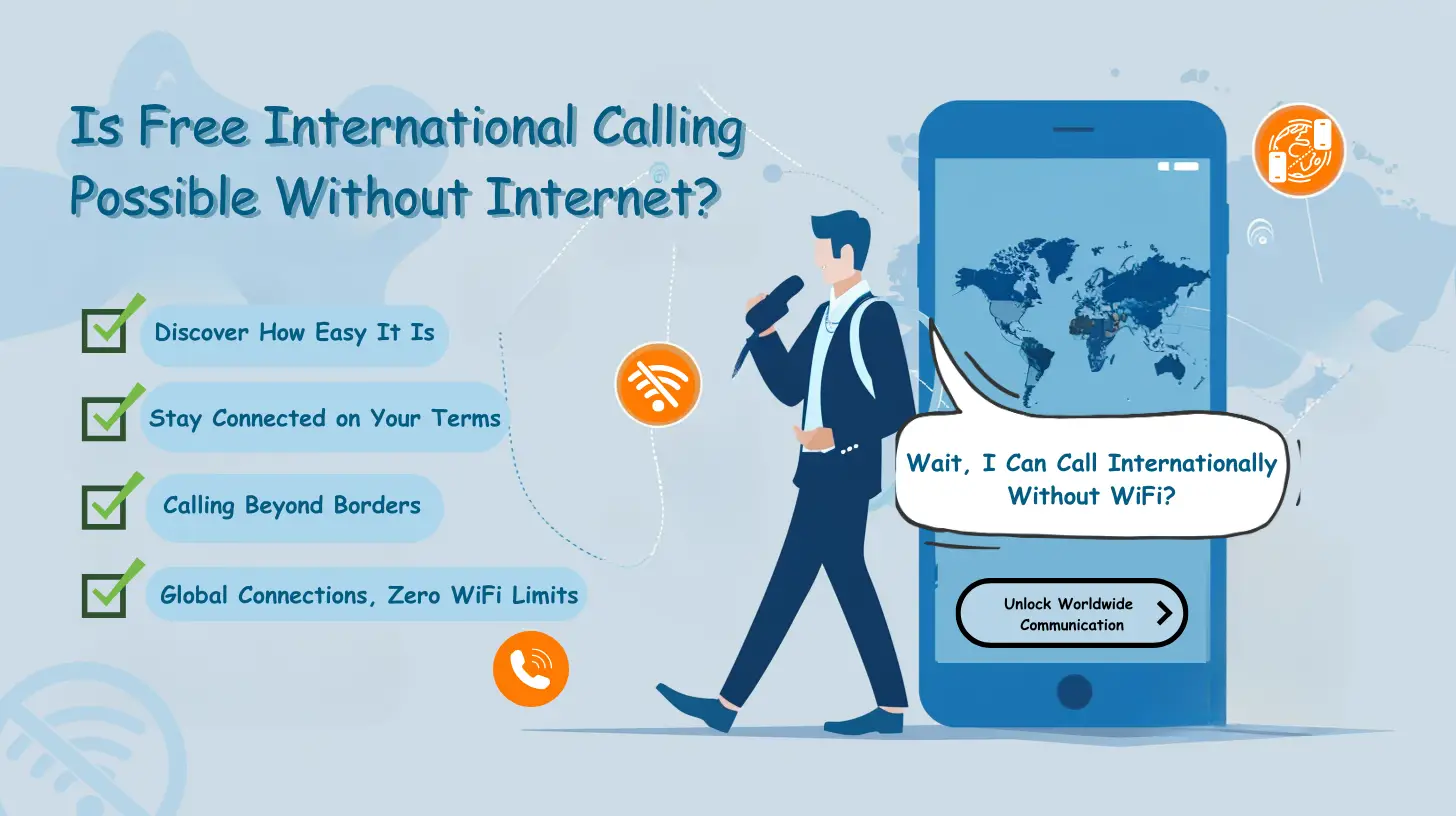SIP Trunking vs VoIP
In the world of IP telephony, two technologies stand out: SIP trunking and VoIP. While they share similarities, understanding the differences between them is crucial. VoIP, or voice over IP, was introduced in 1995 as a cost-effective and flexible solution for real-time voice transmission over a data network. On the other hand, SIP, or Session Initiation Protocol, is a set of protocols that allows for the creation of sessions over the internet, supporting various media modes.
Both SIP trunking and VoIP are vital components of IP-based communications, contributing to the growth of unified communications and collaboration platforms. In this article, we will explore the distinctions between SIP trunking and VoIP, the advantages they offer, and how to choose between them for your business communication needs.
Key Takeaways:
- SIP trunking and VoIP are two crucial technologies in IP telephony.
- VoIP focuses on real-time voice transmission over a data network, while SIP supports various media modes.
- SIP trunking and VoIP are essential for unified communications and collaboration platforms.
- SIP trunking provides advantages like cost savings, scalability, reliability, and real-time analytics.
- VoIP offers benefits such as cost savings, flexibility, scalability, call quality, and security.

Understanding VoIP Technology
In today’s digital age, the advancements in communication technology have transformed the way we connect with one another. One such technology is Voice over IP, commonly known as VoIP. VoIP allows for real-time transmission of voice over a data network, such as the internet, making it a cost-effective and flexible solution for businesses.
Before the advent of VoIP, traditional telephony relied on fixed-line networks operated by phone companies. This meant that phone calls were routed through purpose-built networks, resulting in higher costs and limited flexibility. With VoIP technology, businesses can make and receive calls over the Internet, eliminating the need for traditional phone lines and reducing expenses.
One of the key advantages of VoIP is its scalability. As businesses grow and their communication needs evolve, VoIP systems can easily accommodate these changes without the need for additional hardware or infrastructure. This flexibility allows companies to adapt their communication setup to suit their specific requirements, ensuring efficient and seamless operations.

Benefits of VoIP Technology
VoIP technology offers several benefits that make it a preferred choice for businesses:
- Cost Savings: VoIP calls are typically cheaper than traditional phone calls, especially for long-distance and international calls. This can result in significant cost savings for businesses.
- Flexibility: With VoIP, employees can make and receive calls from anywhere with an internet connection. This flexibility is particularly valuable for remote workers and companies with multiple locations.
- Scalability: VoIP systems can easily scale up or down based on the changing needs of a business. Whether expanding or downsizing, VoIP technology can accommodate growth or contraction without hassle.
- Call Quality: When properly configured, VoIP offers high-quality voice calls. Issues such as latency or poor call quality can be addressed by ensuring a stable network and using suitable equipment.
- Security: VoIP systems have built-in security features to protect against unauthorized access and eavesdropping. Encryption and authentication protocols provide a secure communication channel.
| Advantages of VoIP Technology | Description |
|---|---|
| Cost Savings | VoIP calls are cheaper than traditional phone calls, resulting in significant cost savings for businesses. |
| Flexibility | Employees can make and receive calls from anywhere with an internet connection, providing flexibility in communication. |
| Scalability | VoIP systems can easily scale up or down based on the changing needs of a business. |
| Call Quality | When configured correctly, VoIP offers high-quality voice calls. |
| Security | VoIP systems have built-in security features to protect against unauthorized access and eavesdropping. |
Exploring SIP Trunking
SIP trunking is a communications technology that utilizes the Session Initiation Protocol (SIP) to establish connectivity between endpoints and cloud-based communication services. Unlike traditional physical trunks, such as primary rate interface (PRI) lines, SIP trunking enables the transmission of various forms of data traffic, including voice. This technology offers several advantages for businesses, making it a popular choice in the realm of telephony.
One of the key benefits of SIP trunking is cost savings. By eliminating the need for separate phone lines for each employee, businesses can significantly reduce their telephony expenses. This is especially beneficial for organizations with multiple locations or high call volumes. SIP trunks are virtual and can be easily scaled, allowing businesses to adapt their communication infrastructure to meet their evolving needs. Additionally, SIP trunking provides reliable communication by supporting number failover and diverse routing options, ensuring uninterrupted connectivity.
Advantages of SIP Trunking:
- Cost savings from eliminating separate phone lines
- Scalability to accommodate business growth
- Reliable communication with number failover and diverse routing options
- Real-time analytics for accurate measurement of call usage and availability
- Centrally managed communication for improved efficiency
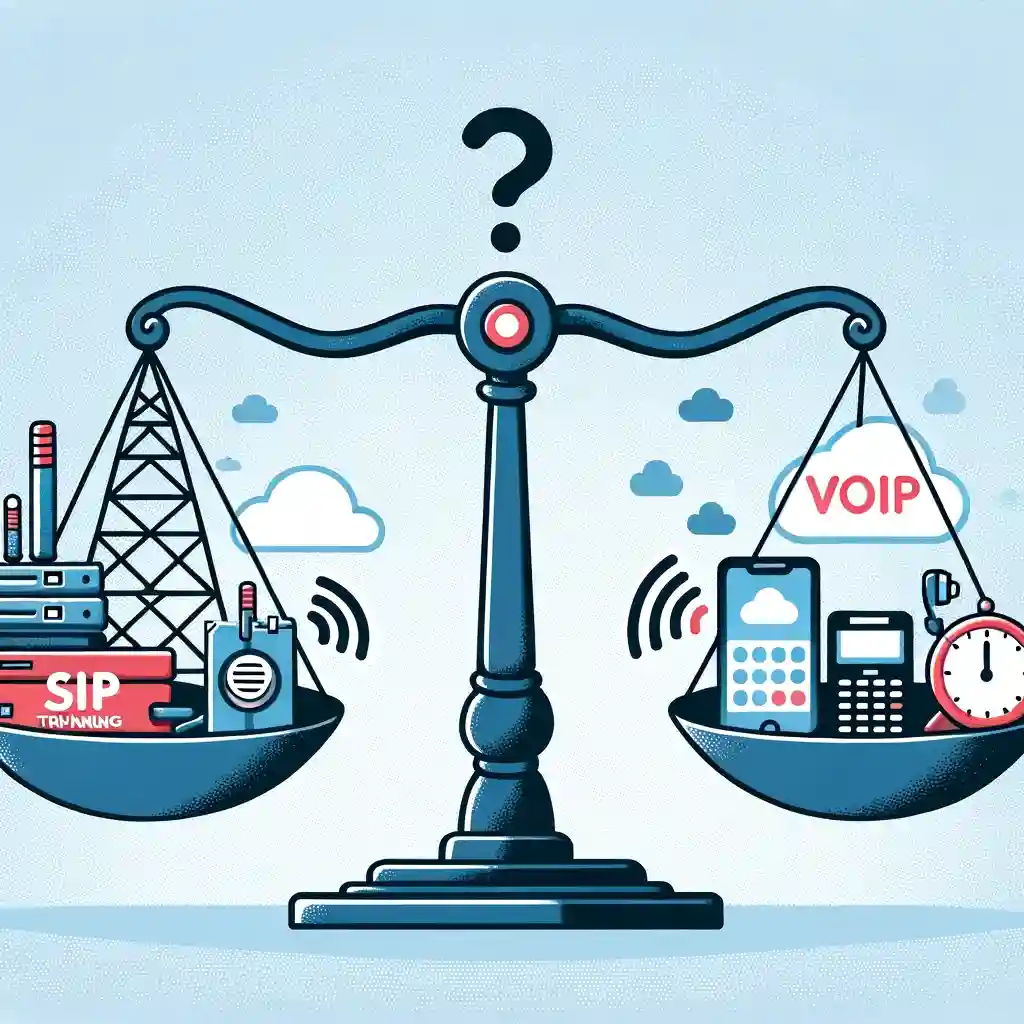
Furthermore, SIP trunk offers real-time analytics and data insights, enabling businesses to gain valuable information about their communication patterns. These insights can be leveraged to enhance various aspects of the business, including marketing, customer service, and sales. Additionally, centrally managed communication simplifies the management of communication systems and improves overall efficiency. By consolidating communication services into a single platform, businesses can streamline their operations and effectively manage their communications.
| SIP Trunking | VoIP | |
|---|---|---|
| Connectivity | Uses Session Initiation Protocol (SIP) to enable connectivity between endpoints and cloud-based communication services | Runs over SIP trunks or other forms of connectivity |
| Advantages |
|
|
In summary, SIP trunking offers numerous advantages over traditional phone services and VoIP. Its cost-effectiveness, scalability, reliability, real-time analytics, and centrally managed communication make it an attractive choice for businesses. By understanding the benefits of SIP trunking and its capabilities, businesses can optimize their communication systems and drive improvements in various areas.
SIP Trunking vs VoIP: Comparing the Similarities and Differences
When it comes to IP-based communications, SIP trunking and VoIP are two essential technologies that businesses rely on. While they share similarities, it’s important to understand their differences and how they serve different purposes in the realm of communication.
Let’s start by comparing the similarities between SIP trunking and VoIP. Both technologies enable voice communication over data networks, allowing businesses to save costs and increase scalability. They provide alternatives to traditional phone services by utilizing internet connectivity for voice transmission. SIP trunking and VoIP also contribute to the growth of unified communications and collaboration platforms, enabling businesses to integrate voice communication with other modes of communication.
Despite these similarities, there are distinct differences between SIP trunking and VoIP. SIP trunking, as the name suggests, focuses on providing the connection between endpoints, such as IP PBX or SIP phones, and cloud-based communication services. It replaces traditional physical trunks, such as PRI lines, and supports various forms of data traffic, including voice.
On the other hand, VoIP is primarily a phone service that runs over SIP trunks or other forms of connectivity. While it utilizes SIP trunks for voice transmission, it is not limited to just voice communication. VoIP systems can integrate with other communication and collaboration tools, offering a more comprehensive solution for businesses.
| SIP Trunking | VoIP | |
|---|---|---|
| Focus | Connectivity between endpoints and cloud-based services | Phone service running over SIP trunks or other connectivity options |
| Main Purpose | Enabling various forms of data traffic, including voice, video, and messaging | Enabling voice communication and integration with other tools |
| Key Features | Cost savings, scalability, reliability, real-time analytics, centrally managed communication | Cost savings, flexibility, scalability, call quality, security, integration |
As businesses consider their communication needs, factors such as cost, scalability, reliability, and feature requirements should be taken into account when choosing between SIP trunking and VoIP. Assessing these factors will help businesses make an informed decision and optimize their communication systems to suit their specific needs.

Summary
SIP trunking and VoIP are integral to IP-based communications, offering cost savings, scalability, and integration capabilities. While SIP trunking focuses on connectivity between endpoints and cloud-based services, VoIP is a phone service that runs over SIP trunks or other connectivity options. Understanding the differences between these technologies can help businesses make the right choice for their communication needs.
Advantages of SIP Trunking
SIP trunking offers several advantages over traditional phone services and VoIP. Let’s explore the key benefits that make SIP trunking a preferred choice for businesses.
1. Cost-Effective Telephony:
SIP trunking eliminates the need for separate phone lines for each employee, resulting in significant cost savings. By leveraging existing internet connections, businesses can reduce their telephony expenses and enjoy more affordable communication without compromising on quality.
2. Scalability and Reliability:
SIP trunks are virtual and can be easily scaled to accommodate changing business needs. Whether it’s adding new lines or expanding to multiple locations, SIP trunking provides the flexibility to grow without the hassle of physical infrastructure. Additionally, SIP trunking offers reliable communication through failover options and diverse routing, ensuring uninterrupted connectivity for enhanced business operations.
3. Real-Time Analytics and Centrally Managed Communication:
With SIP trunking, businesses gain access to real-time analytics and insights. These analytics enable accurate measurement of call usage and availability, empowering organizations to optimize their communication strategies and improve overall performance. Furthermore, SIP trunking allows for centrally managed communication systems, simplifying administrative tasks and ensuring efficient operations.
Considering these advantages, it’s clear that SIP trunking offers a cost-effective, scalable, and reliable solution for businesses seeking more advanced communication capabilities. By leveraging SIP trunking technology, organizations can drive productivity, enhance customer service, and optimize their communication systems for future success.

| Advantages of SIP Trunking | Benefits |
|---|---|
| Cost-Effective Telephony | Significant cost savings by eliminating the need for separate phone lines |
| Scalability and Reliability | Virtual and easily scalable trunks, reliable communication with failover options |
| Real-Time Analytics and Centrally Managed Communication | Access to real-time analytics, insights, and simplified management |
Source:
Benefits of VoIP
VoIP offers several benefits over SIP trunking and traditional phone services. One of the primary advantages is cost savings. VoIP calls are typically cheaper than traditional phone calls, especially for long-distance and international calls. This can result in significant savings for businesses with high call volumes or multiple locations.
Flexibility is another key benefit of VoIP. With VoIP, users can make and receive calls from any location with an internet connection. This is particularly beneficial for remote workers and businesses with multiple offices or branches. The ability to connect and communicate from anywhere enhances productivity and collaboration.
Scalability is also an advantage of VoIP. As businesses grow and communication needs change, VoIP systems can easily be scaled to accommodate the increased demand. This flexibility allows businesses to adapt and expand without the need for significant infrastructure upgrades.
In terms of call quality, VoIP systems can provide high-quality voice communication as long as the network and equipment are properly configured. With the right setup, VoIP calls can rival or even exceed the quality of traditional telephone calls.
Lastly, VoIP systems have built-in security features to protect communication and data. Encryption and other security measures ensure that calls and messages are secure from unauthorized access. Additionally, VoIP can be seamlessly integrated with other communication and collaboration tools, further enhancing efficiency and productivity.
Benefits of VoIP
| Advantages | Description |
|---|---|
| Cost Savings | VoIP calls are typically cheaper than traditional phone calls, resulting in significant cost savings. |
| Flexibility | VoIP allows users to make and receive calls from any location with an internet connection, enhancing flexibility and collaboration. |
| Scalability | VoIP systems can easily be scaled to accommodate the changing communication needs of businesses. |
| Call Quality | With proper configuration, VoIP calls can provide high-quality voice communication. |
| Security | VoIP systems have built-in security features to protect communication and data. |
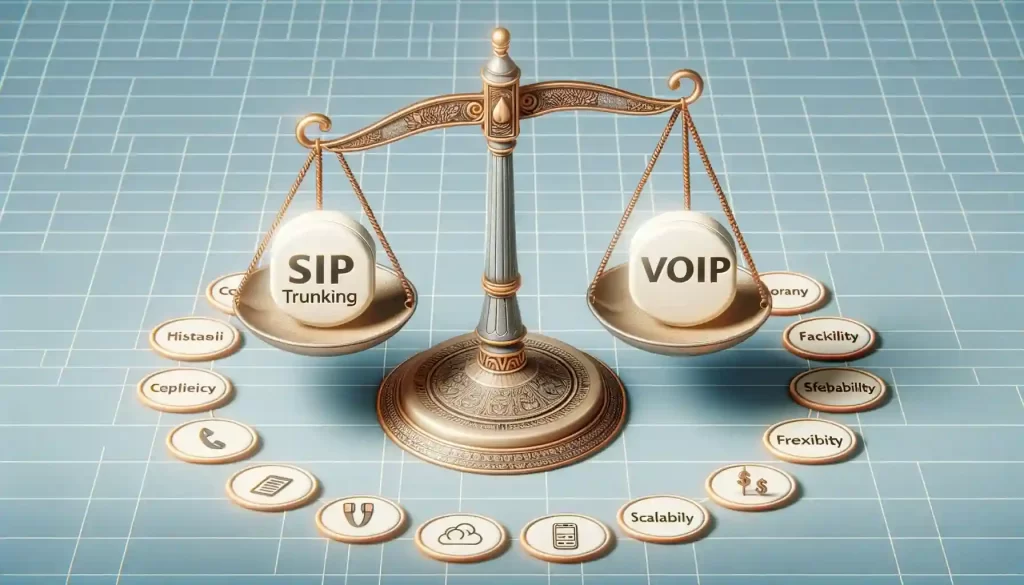
Choosing Between SIP Trunking and VoIP
When it comes to business communication, choosing between SIP trunking and VoIP can be a crucial decision. Several factors need to be considered to ensure the right choice is made. Here are some key considerations for businesses:
- Cost: Cost is often a major deciding factor for businesses. Both SIP trunking and VoIP offer cost savings compared to traditional phone services. However, it’s important to analyze the specific cost structures and pricing plans of each option to determine which one aligns better with the organization’s budget.
- Scalability: Scalability is essential, especially for businesses that anticipate growth or have fluctuating communication needs. SIP trunking and VoIP both offer scalability options, but it’s important to evaluate which technology provides the most flexibility and ease of expansion.
- Reliability: Reliability is a crucial aspect of any communication system. It’s important to assess the network infrastructure and service level agreements offered by SIP trunking and VoIP providers. Businesses should consider factors such as uptime guarantees, redundancy options, and disaster recovery plans.
- Features: Not all businesses have the same communication requirements. It’s important to evaluate the specific features and functionalities offered by SIP trunking and VoIP. Determine which technology aligns better with the organization’s needs, such as call routing, call recording, voicemail, and integration capabilities with other tools and systems.
- Integration: Integration with existing systems and tools can streamline communication processes and enhance productivity. Evaluate how well SIP trunking and VoIP integrate with other business-critical applications, such as customer relationship management (CRM) software, email clients, and collaboration platforms.
Choosing between SIP trunking and VoIP requires careful consideration of these factors. It is recommended to assess the specific needs and goals of the business to determine the most suitable technology for communication. Remember, what works for one business may not work for another, so take the time to evaluate the options and make an informed decision.
SIP Trunking vs VoIP Technology
When comparing SIP trunking and VoIP technology, it is important to understand the similarities and differences between the two. Both SIP trunking and VoIP play a crucial role in IP-based communications, enabling businesses to save costs, increase scalability, and enhance reliability.
SIP trunking is a technology that allows for connectivity between endpoints, such as IP PBX or SIP phones, and cloud-based communication services. It serves as the connection for voice and data traffic, supporting various media modes including voice, video, and messaging. In contrast, VoIP is a phone service that runs over SIP trunks or other connectivity options. It focuses solely on voice communication and is widely used in enterprises, replacing traditional fixed-line telephony systems.
While both technologies facilitate voice communication over data networks and offer cost savings and scalability, SIP trunking supports a broader range of media modes and provides more flexibility in terms of communication options. VoIP and wholesale voip termination rates, on the other hand, is specifically designed for voice communication and offers high call quality and security features. Businesses should consider their specific communication needs and goals when choosing between SIP trunking and VoIP technology.
Table: A Comparison of SIP Trunking and VoIP Technology
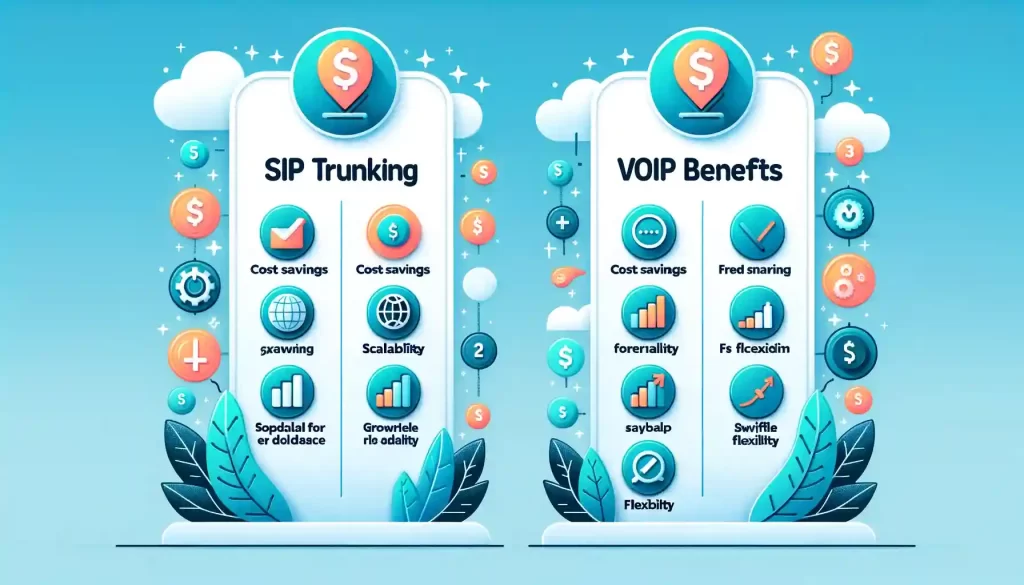
| SIP Trunking | VoIP | |
|---|---|---|
| Technology | Enables connectivity between endpoints and cloud-based services | Phone service that runs over SIP trunks or other connectivity options |
| Media Modes | Supports voice, video, and messaging | Specifically focused on voice communication |
| Cost Savings | Eliminates the need for separate phone lines, reducing costs | Cheaper than traditional phone calls, especially long-distance and international |
| Scalability | Easily scaled to accommodate changing business needs | Suitable for businesses with fluctuating communication demands |
| Reliability | Offers number failover and diverse routing options for reliable communication | Dependent on network infrastructure and equipment configuration |
| Features | Provides real-time analytics and centrally managed communication | Offers high call quality and can be integrated with other communication tools |
In summary, SIP trunking and VoIP technology are essential for IP-based communications, but they differ in terms of connectivity, media modes, and focus. SIP trunking supports various media modes and provides more flexibility, while VoIP is primarily focused on voice communication. Businesses should consider their specific communication needs and goals when choosing between SIP trunking and VoIP technology to optimize their communication systems.
Conclusion
In conclusion, understanding the difference between SIP trunking and VoIP is crucial for businesses seeking efficient and cost-effective communication solutions. Both technologies have their unique advantages and play a significant role in IP-based communications. SIP trunking, with its support for various media modes including voice, video, and messaging, provides robust connectivity between endpoints and cloud-based services. On the other hand, VoIP offers a flexible phone service that runs over SIP trunks or other connectivity options.
When deciding between SIP trunking and VoIP, businesses should consider factors such as cost, scalability, reliability, features, and integration requirements. SIP trunking provides cost savings by eliminating the need for separate phone lines and offers scalability and reliability through virtual trunks and diverse routing options. Additionally, it provides real-time analytics and centrally managed communication for improved efficiency. VoIP, on the other hand, offers cost savings, flexibility, scalability, high call quality, and built-in security features.
By carefully evaluating their specific needs and goals, businesses can choose the most suitable technology for their communication requirements. Whether it’s SIP trunking or VoIP, both technologies contribute to the growth of unified communications and collaboration platforms, enabling businesses to streamline their communication systems and drive productivity. Having a clear understanding of the differences between SIP trunking and VoIP empowers businesses to make informed decisions that optimize their communication infrastructure and support their overall success.0





